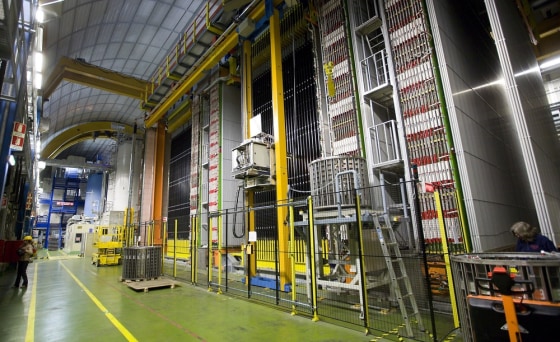Researchers say new tests have confirmed earlier indications that neutrinos can travel faster than light, but not everyone is convinced.
The claim runs so counter to a century's worth of physics that most observers won't be content until the findings from the OPERA experiment are repeated under a variety of conditions, by different teams of researchers. If the results hold up, that would require a reinterpretation of Albert Einstein's special theory of relativity, which effectively sets the velocity of light in a vacuum as a cosmic speed limit.
The latest round of tests was conducted to address some of the criticisms that cropped up in the wake of the OPERA team's initial announcement about faster-than-light neutrinos in September.
"A measurement so delicate and carrying a profound implication [for] physics requires an extraordinary level of scrutiny," Fernando Ferroni, president of the Italian Institute for Nuclear Physics, or INFN, said in a news release. "The experiment OPERA, thanks to a specially adapted CERN beam, has made an important test of consistency of its result. The positive outcome of the test makes us more confident in the result, although the final word can only be said by analogous measurements performed elsewhere in the world."
"OPERA" is a tortured acronym that stands for "Oscillation Project with Emulsion-tRacking Apparatus." The team's researchers shoot beams of neutrinos from the CERN particle-physics center on the French-Swiss border to INFN's Gran Sasso Laboratory, more than 450 miles (730 kilometers) away. The travel time for each pulse of neutrinos is measured to an accuracy of billionths of a second. In the faster-than-light experiment, the researchers reported that the neutrinos arrived 60 nanoseconds earlier than a light beam would have.
The revised experiment sent out 3-nanosecond-long bursts of neutrinos, spaced by as much as 524 nanoseconds, INFN said. "This permits to make a more accurate measure of their velocity, at the price of a much lower beam intensity; only 20 clean events have been collected by OPERA in this phase. Additional events could be eventually collected in the next year run," the institute said.
Jacques Martino, director of France's National Institute of Nuclear and Particle Physics at CNRS, was quoted as saying that the search for potential experimental errors "is not over."
"There are more checks of systematics currently under discussion," he said. "One of them could be a synchronization of the time reference at CERN and Gran Sasso independently from GPS, using possibly a fiber [cable]."
Some physicists criticized the initial experiment because they thought it did not fully account for the relativistic effects of the Global Positioning System, which was used to track the elapsed time as well as the distance traveled between CERN and Gran Sasso.
INFN said the updated results have been submitted for review and publication in the Journal of High Energy Physics. But ScienceInsider's Edwin Cartlidge reported that about 15 of the experiment's nearly 200 collaborators have declined to lend their names to the journal submission, on the grounds that further confirmation is required.
An unnamed source on the OPERA team told ScienceInsider that the controversy over the faster-than-light findings was exhausting. "Everyone should be convinced that the result is real, and they are not," the source was quoted as saying.
Other researchers, including physicists with the MINOS experiment at Fermilab, are working up independent analyses of neutrino runs to assess the OPERA team's findings. The initial outside assessments are expected to become available within six months or so, but end-to-end replications of the experiment could take significantly longer.
Update for 2 p.m. ET Nov. 18: In response to some of the comments below, I've changed the headline on this item, which originally read "Faster-than-light neutrinos confirmed." I realize the new headline still implies that superluminal neutrinos actually exist even though the evidence for that is in dispute, but I hope you'll understand that this is shorthand for "New experiment continues to support hypothesis about faster-than-light neutrino travel."
More on the faster-than-light controversy:
- Neutrinos spark wild scientific leaps
- Faster-than-light neutrinos? Not so fast, some say
- Challenging Einstein is usually a losing venture
- Interactive: Putting Einstein to the test
- 'Virtually Speaking Science': Podcast on weird physics
Connect with the Cosmic Log community by "liking" the log's Facebook page, following @b0yle on Twitter or following the Cosmic Log Google+ page. You can also check out "The Case for Pluto," my book about the controversial dwarf planet and the search for new worlds.
